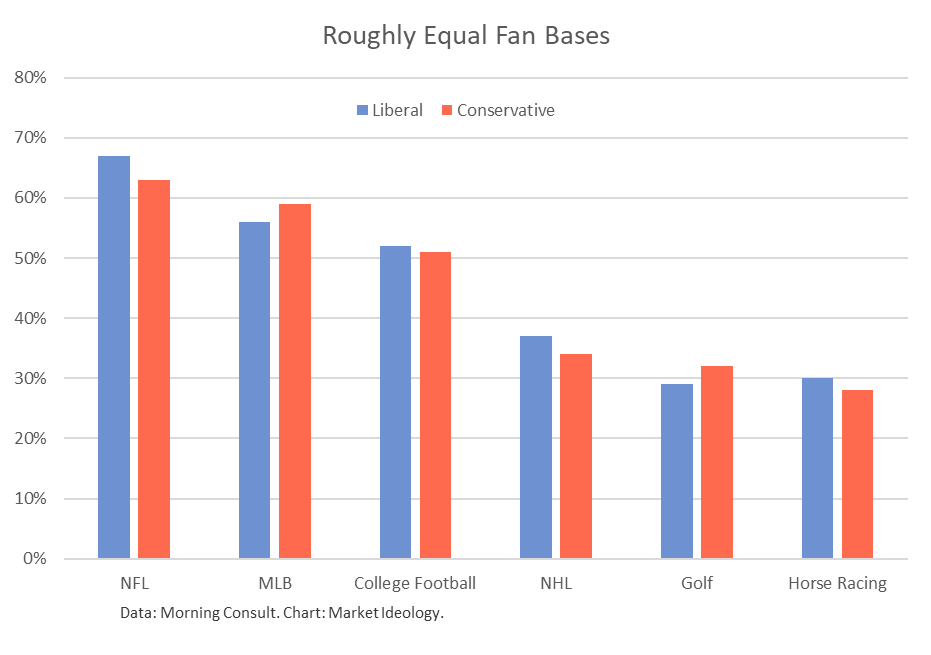Conservative and liberal customers love sports, which means businesses love sports advertising, celebrities, endorsements, and sponsorships. According to new research by Morning Consult, the two fan favorites are NFL and MLB, each attracting about an equal amount of attention from conservative and liberal customers.
The mostly even split between liberal and conservative fans in the NFL and MLB has significant implications for those businesses that invest in them to attract more customers. If a company has customers split evenly between liberal and conservative, these two leagues are great opportunities to reach more customers without wasting money on one side or the other.
Here are other sports that have an almost even number of self-reported fans:
Most businesses, however, do not attract an equal number of liberal and conservative customers. Leadership, products, brand, locations, retail distribution, or the market creates an imbalance of worldview among customers. That’s not a problem unless you aren’t aware of it. Without awareness of customer worldview makeup, it’s easy to make investments in sports or other media that don’t align with how your customers think. It’s like pursuing men when it’s women buying your products.
Here are the sports that have more lopsided fan bases:
So if your business attracts conservative customers, having a sponsorship or running a lot of advertising in the NBA may be a mistake. Your investment will be far less efficient than a sponsorship in motorsports. You will spend more to acquire a new customer due to worldview misalignment.
Not every business can afford such investments, but this illustrates how worldview misalignment between customers and marketing investment can significantly impact efficiency. Yet very few businesses look at these differences, assuming that “sports” represents a general category where the people are mostly the same.
Businesses may think about customers having some combination of gender, income, generation, or purchase behavior without considering worldview. Yet, worldview is the highest level of customer insight because it represents how customers see the world and what they believe to be true.
You could argue that targeting the smaller “other side” is a strategy for growing that business segment. That may or may not work depending on how strongly your brand and products align with the less dominant segment.
Customers that buy from you in smaller amounts will likely have higher acquisition costs when you focus on them exclusively. Unless you fundamentally change how you talk to them, you will likely spend more to acquire these customers. You can certainly test this approach using less-expensive social media.
How Sports Attract Both Groups for the Same and Different Reasons
Sports are about winning and competition, two defining characteristics of American culture and the basis for the American Dream. Watching sports can tap into qualities of individualism and meritocracy, where if you try hard enough, you can succeed. Individualism is the common foundation for both groups in our customer model.
Yet not all Americans have strong individualist streaks, and there is evidence that each of the two groups may enjoy sports entertainment for different reasons. For example, a previous article explored how liberal and conservative customers perceive success differently. For conservative customers, success is more positional, or as a research study indicated, they seek “vertical differentiation.” Success for liberal customers, on the other hand, is more about “horizontal differentiation,” which aligns with a more egalitarian mindset.
No current research links the concepts of “vertical” or “horizontal” perceptions of success to the enjoyment of watching sports, so we will explore this in original research at Market Ideology. The hypothesis is that a preference for hierarchy or “vertical” success with conservative customers may promote the desire for strength and domination. The hypothesis for liberal customers is that there may be a preference for skills mastery and a more egalitarian preference for equality in teamwork. At this point, it’s a hypothesis. We’ll publish any results in a future issue of this newsletter.
Regardless of the potential differences between the two groups, clear elements unite conservative and liberal customers, even with variations by sport. If your investments involve professional sports, this new research is invaluable for understanding alignment. If you don’t invest in professional sports, think of any marketing or PR investments to determine if there is worldview alignment with those who buy from you. Either way, it’s an exercise that costs you little or nothing to improve efficiency and growth.



